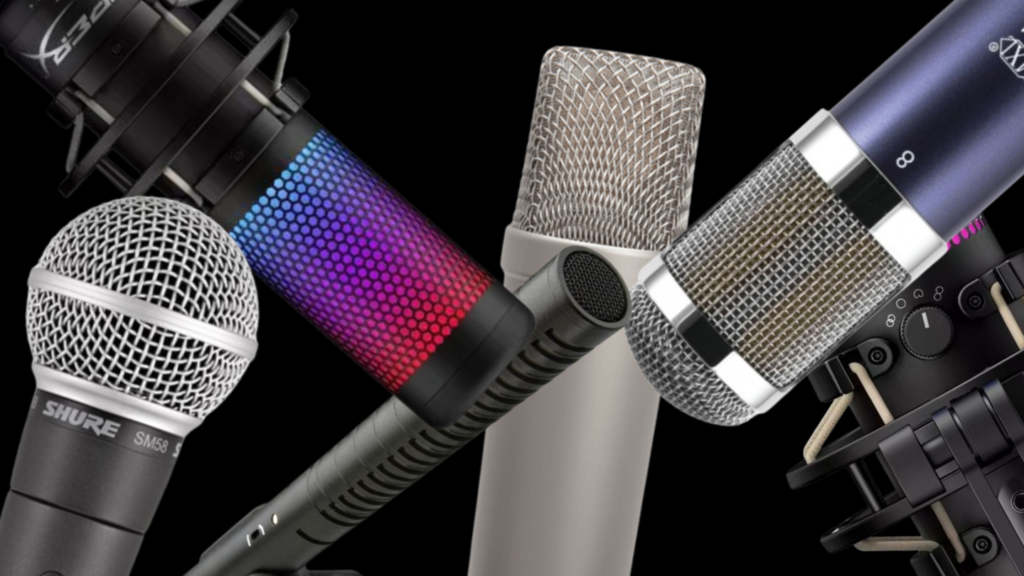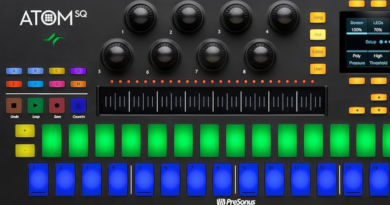What Microphone do you need?
Whether you’re a budding podcaster, a rising YouTube star, or a seasoned music producer, understanding the different types of microphones and their specific uses can elevate your audio game significantly. The world of microphones is vast and varied, but fear not! We’re here to break it down, making it easy and fun to get to grips with these essential tools. Let’s dive into the main types of microphones and uncover which mic fits best for various applications.
Dynamic Microphones
Dynamic microphones are the tough cookies of the audio world. Known for their ruggedness and durability, these mics can handle high sound pressure levels (SPL) making them ideal for capturing loud sources.

Perfect for live performances, dynamic microphones excel in capturing drums, electric guitars, and vocals on stage. Their ability to withstand loud noises without distorting makes them a staple for any live sound toolkit. Models like the Shure SM58 are beloved by vocalists for their reliability and ability to pull a clear sound even in the noisiest environments.
Condenser Microphones
Condenser microphones are like the sensitive artists of the mic world — excellent at picking up subtle nuances and higher frequencies. These mics require power, either from a battery or a phantom power source provided by a mixer or audio interface, due to their internal active electronics.

In the studio, condenser mics are the go-to for capturing vocals and acoustic instruments thanks to their detailed sound reproduction. They’re also a top choice for voice-over work and any situation where clarity and precision are paramount. The Rode NT1A, for instance, is a popular choice in studios for everything from strings to percussion, owing to its detailed capture and versatility.
Ribbon Microphones
Ribbon microphones, with their delicate ribbon-like material that vibrates within a magnetic field, offer a vintage vibe. They’re known for their warm, natural sound reproduction but are typically more fragile than dynamic or condenser mics.

Ideal for capturing the warmth in vocals and the smoothness in high-frequency instruments like violins and acoustic guitars, ribbon mics are a favorite in studio settings for those looking to add a classic touch to their recordings. They are fantastic for miking guitar amps and brass instruments, offering a sound that is often described as smooth and lush.
Shotgun Microphones
Shotgun microphones have a highly directional pickup pattern that allows them to capture sound from a narrow area, minimizing ambient noise. This makes them particularly useful in film and television production.

Used on film sets and for outdoor broadcasts, shotgun mics are excellent at picking up dialogue from a distance while rejecting off-axis sounds. They’re typically mounted on booms or stands and are essential for achieving clear audio capture in film and video environments.
USB Microphones
USB microphones are the plug-and-play solution for quick and easy audio recording. These mics contain all the necessary preamps and analog-to-digital converters internally, which means they can be connected directly to a computer without needing additional audio hardware.

USB microphones are perfect for podcasters, streamers, and anyone looking to get good quality recordings with minimal setup. They’re also a great tool for musicians who want to lay down a quick demo without setting up a bunch of equipment. The Blue Yeti, for instance, is a popular choice among podcasters for its ease of use and versatile pickup patterns.
Conclusion
From the rugged dynamics to the sensitive condensers, each type of microphone serves a unique purpose and brings its own flavor to the audio captured. Whether you’re recording a garage band, Studio Vocals, or a solo podcast, there’s a microphone out there that’s perfectly suited to your needs. Understanding these types will help you make informed decisions and ultimately lead to better sound quality in whatever project you’re tackling. So, go forth and record with confidence, knowing you’ve got the right mic for the job!




